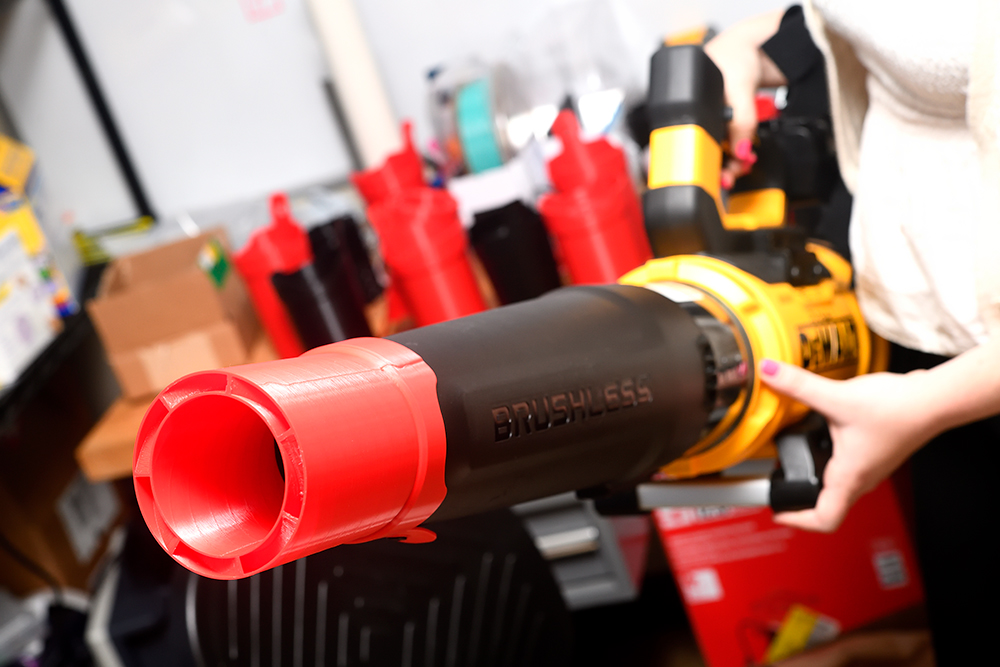周末喜欢懒觉的郊区居民有福了。约翰霍普金斯大学的四名工程专业的本科生近日设计出了一款新型的落叶清扫机消音器,从而终于让这种聒噪的机器安静了下来。
这四名学生现就读于约翰霍普金斯大学的惠廷工程学院,这项发明也是他们的毕业设计作业。在发明过程中,他们还得到了全球最大的工具公司Stanley Black and Decker的资助,该公司的年销售额达158亿美元。Stanley对他们的发明赞不绝口,并决定向公众销售。预计这款产品两年内就会上市售卖,预期售价暂未确定。
该产品的发明者们介绍道,这款产品采用了所谓的“螺旋帽”技术,它能使空气在落叶清扫机的喷气嘴周围旋转,从而降低噪音。而且它的螺旋帽采取了特殊的几何设计,可以使喷气嘴发出的声波发生转向——这与汽车的降噪器和枪支消音器的工作原理并无二致。该项目的发明者之一迈克尔·查肯介绍道,它的关键技术就在于既要降低落叶清扫机的风机噪音,同时又要让它喷出足够的空气,使它足以清理满是落叶的草坪。(查肯计划毕业后在一家小型航天公司工作)。
清扫草坪上的落叶是一件很费时费力的事,尤其是到了秋天,这是一项令很多美国人感到头疼的工作。与人工清扫相比,落叶清扫机的噪声问题虽然很恼人,但它毕竟大大提高了工作效率。根据市场研究公司Research and Markets的数据,截止到2022年,落叶清扫机在全球已经是一个价值15亿美元的产业了。

而在研究如何降低落叶清扫机的噪音的问题上,这四位初出茅庐的大学生给他们的教授和Stanley公司都留下了深刻印象。
作为他们的导师,约翰霍普金斯大学工程学教授斯蒂芬·贝尔科夫评价道:“这是一个特别团结而且有凝聚力和专注力的团队。他们有一马当先的精神,而且也是一个有趣的团队。”
在研发过程中,Stanley公司的经理内特·格林也为学生们提供了一些咨询和建议。格林也是约翰霍普金斯大学的毕业生,而且同样也曾是贝尔科夫的学生。贝尔科夫表示,这让他“特别有成就感”。他还表示,他觉得格林对他的师弟师妹们有些过于严厉了。
这个塑料消音器看起来很不起眼,它可以作为落叶清扫机的一个附件,直接拧在清扫机的喷嘴上,不过它的效果是很显著的,可以让落叶清扫机的整体噪音降低38%。格林表示:“这项发明大大改善了噪音问题,特别是它直接瞄准了人耳最敏感的频率”。据查肯介绍,项目组在最终敲定“螺旋帽”方案之前,还设计过40多个方案。
Stanley公司很想尽快推动这款产品上市售卖,它还派出一支律师团队,代表四名学生申请了发明专利。目前专利申请已经进入了审核阶段。发明小组成员之一的麦迪逊·莫里森说,她本月月底拿到学位后,将继续攻读博士学位,并表示这项专利是她的一个“重大成就”,也让她对工程学有了新的认识。
莫里森表示:“这个过程真的很酷,因为它展示了工程领域的一个侧面。换句话说,你怎样证明这个发明是你的?你要怎样从法律层面来充分拥有它?”
根据Stanley公司与约翰霍普金斯大学的协议,该公司将保留该产品的全部知识产权和后续专利费用,不过四名学生的名字仍将出现在专利上。
学生们则表示,他们很享受将一个点子转变成一个商业产品的过程。莫里森表示:“这是一个很酷的例子,你可以把一些非常理论性的东西,比如一些研究性的想法,真正地投入到实际应用当中去。”

研发小组的另一个成员安德鲁·帕拉西奥介绍道,他们的原型产品是用3D打印技术做出来的。但是项目接近尾声的时候,格林要求他们必须重新设计产品,以便公司能采用更适合批量生产的注塑模具来进行生产。也就是在这个时候,他们意识到,Stanley公司是真的看到了他们的产品的销售潜力。
“几个月前的一天,我们的赞助商(格林)非常严厉地要求我们,必须想办法解决大规模量产的技术问题。那时候我才意识到:‘哦,这东西可能有一天真的会被摆上货架。’”帕拉西奥说。
不过有一件事这四名学生目前还不能确定,那就是他们毕业设计的成绩。当被问到他们有没有信心拿到A时,四个学生都笑了。“我们现在还不知道呢。”(财富中文网)
译者:朴成奎
周末喜欢懒觉的郊区居民有福了。约翰霍普金斯大学的四名工程专业的本科生近日设计出了一款新型的落叶清扫机消音器,从而终于让这种聒噪的机器安静了下来。
这四名学生现就读于约翰霍普金斯大学的惠廷工程学院,这项发明也是他们的毕业设计作业。在发明过程中,他们还得到了全球最大的工具公司Stanley Black and Decker的资助,该公司的年销售额达158亿美元。Stanley对他们的发明赞不绝口,并决定向公众销售。预计这款产品两年内就会上市售卖,预期售价暂未确定。
该产品的发明者们介绍道,这款产品采用了所谓的“螺旋帽”技术,它能使空气在落叶清扫机的喷气嘴周围旋转,从而降低噪音。而且它的螺旋帽采取了特殊的几何设计,可以使喷气嘴发出的声波发生转向——这与汽车的降噪器和枪支消音器的工作原理并无二致。该项目的发明者之一迈克尔·查肯介绍道,它的关键技术就在于既要降低落叶清扫机的风机噪音,同时又要让它喷出足够的空气,使它足以清理满是落叶的草坪。(查肯计划毕业后在一家小型航天公司工作)。
清扫草坪上的落叶是一件很费时费力的事,尤其是到了秋天,这是一项令很多美国人感到头疼的工作。与人工清扫相比,落叶清扫机的噪声问题虽然很恼人,但它毕竟大大提高了工作效率。根据市场研究公司Research and Markets的数据,截止到2022年,落叶清扫机在全球已经是一个价值15亿美元的产业了。
而在研究如何降低落叶清扫机的噪音的问题上,这四位初出茅庐的大学生给他们的教授和Stanley公司都留下了深刻印象。
作为他们的导师,约翰霍普金斯大学工程学教授斯蒂芬·贝尔科夫评价道:“这是一个特别团结而且有凝聚力和专注力的团队。他们有一马当先的精神,而且也是一个有趣的团队。”
在研发过程中,Stanley公司的经理内特·格林也为学生们提供了一些咨询和建议。格林也是约翰霍普金斯大学的毕业生,而且同样也曾是贝尔科夫的学生。贝尔科夫表示,这让他“特别有成就感”。他还表示,他觉得格林对他的师弟师妹们有些过于严厉了。
这个塑料消音器看起来很不起眼,它可以作为落叶清扫机的一个附件,直接拧在清扫机的喷嘴上,不过它的效果是很显著的,可以让落叶清扫机的整体噪音降低38%。格林表示:“这项发明大大改善了噪音问题,特别是它直接瞄准了人耳最敏感的频率”。据查肯介绍,项目组在最终敲定“螺旋帽”方案之前,还设计过40多个方案。
Stanley公司很想尽快推动这款产品上市售卖,它还派出一支律师团队,代表四名学生申请了发明专利。目前专利申请已经进入了审核阶段。发明小组成员之一的麦迪逊·莫里森说,她本月月底拿到学位后,将继续攻读博士学位,并表示这项专利是她的一个“重大成就”,也让她对工程学有了新的认识。
莫里森表示:“这个过程真的很酷,因为它展示了工程领域的一个侧面。换句话说,你怎样证明这个发明是你的?你要怎样从法律层面来充分拥有它?”
根据Stanley公司与约翰霍普金斯大学的协议,该公司将保留该产品的全部知识产权和后续专利费用,不过四名学生的名字仍将出现在专利上。
学生们则表示,他们很享受将一个点子转变成一个商业产品的过程。莫里森表示:“这是一个很酷的例子,你可以把一些非常理论性的东西,比如一些研究性的想法,真正地投入到实际应用当中去。”
研发小组的另一个成员安德鲁·帕拉西奥介绍道,他们的原型产品是用3D打印技术做出来的。但是项目接近尾声的时候,格林要求他们必须重新设计产品,以便公司能采用更适合批量生产的注塑模具来进行生产。也就是在这个时候,他们意识到,Stanley公司是真的看到了他们的产品的销售潜力。
“几个月前的一天,我们的赞助商(格林)非常严厉地要求我们,必须想办法解决大规模量产的技术问题。那时候我才意识到:‘哦,这东西可能有一天真的会被摆上货架。’”帕拉西奥说。
不过有一件事这四名学生目前还不能确定,那就是他们毕业设计的成绩。当被问到他们有没有信心拿到A时,四个学生都笑了。“我们现在还不知道呢。”(财富中文网)
译者:朴成奎
Suburban dwellers hoping to sleep in on the weekend might want to thank a group of engineering students from Johns Hopkins University. Four undergraduates designed a new leaf blower silencer that quiets the otherwise raucous piece of machinery.
The four designed the product as part of their senior capstone in the university’s Whiting School of Engineering, under the sponsorship of Stanley Black and Decker, the world’s largest tool company with $15.8 billion in annual sales. Stanley was so impressed with their invention, it decided to sell it to the public, and the silencer is expected to hit shelves within the next two years at a yet-to-be-determined price, according to the company.
The product itself is what the group calls a “helical cap” that swirls air around the nozzle of the leaf blower to lessen the noise. The specific geometrical design of the cap, the students explained, shifts the soundwaves that come out of the blower’s long nozzle—the same way a car muffler or a silencer on a gun works. The trick was reducing the blower’s noise while still having it blow enough air to actually be able to clean up a leaf-strewn lawn, said Michael Chacon, one of the students on the project. (Chacon plans to work for a small aerospace company when he graduates.)
Leaf blowers have long had a reputation for being a disruptive part of suburban life, with their distinct monotonous roar a staple of autumn leaf-gathering across the U.S. Aside from being an irritating, if convenient, alternative to raking leaves manually, leaf blowers also represent a $1.5 billion global industry as of 2022, according to market research firm Research and Markets.
As they investigated quieter leaf-clearing, the group impressed both their professors and Stanley Black and Decker.
“This was an especially tight-knit, cohesive, focused group,” said the students’ academic advisor and Johns Hopkins engineering professor Stephen Belkoff. “They hit the ground running. They’re a fun group.”
A Stanley Black and Decker manager, Nate Greene, advised the students. Greene himself was both a graduate of Johns Hopkins and a former student of Belkoff’s. That made it “especially rewarding,” Belkoff says—adding that Greene was “a bit of a taskmaster” with the students.
The cap looks rather unassuming, a plastic cylindrical attachment that is screwed onto the end of the blower, but its results are notable, reducing the contraption’s overall noise by 37%. “The invention dramatically improves the quality of the noise, specifically targeting the frequencies the human ear is most sensitive to,” Greene said. The group went through about 40 versions of the helical cap before they landed on the final one, according to Chacon.
Stanley Black and Decker was so eager to get the leaf blower silencer in stores that it dispatched patent attorneys to secure a patent application on behalf of the four students. The patent is now pending. Madison Morrison, one of the group members who says she’s off to do her PhD when she graduates later this month, called the patent a “big accomplishment” that gave her a new perspective on engineering.
“That process was really cool, because it was a little bit of a different side of the engineering field,” Morrison said. “How do you prove your invention? How do you fully capture it from a legal perspective?”
As part of Stanley Black and Decker’s agreement with Johns Hopkins, the company retains all the intellectual property and subsequent royalties from their design, but the students’ name will appear on the patent.
For their part, the students said they enjoyed the process of going from ideation to a product that a business can sell. “This was a cool example of how you can take something super theoretical, that’s maybe only some research idea, and then actually put it into practical use,” Morrison said.
Toward the end of the project, Greene asked the group to redesign their product so it could be manufactured using an injection mold, which is better suited for mass production, instead of 3D printing, which they had used for their prototypes, according to Andrew Palacio, a member of the group. That’s when they realized Stanley Black and Decker saw real potential in their design.
“Our sponsor [Greene] sat down with us one day a few months ago and had a very stern order to find a way to mass produce the cap,” Palacio says. “That’s when I at least realized, ‘oh this is probably going to end up on a shelf one day.’”
But one thing the group is still not sure of—their grades. When asked if they got an A, all four laughed, “We don’t know yet.”






